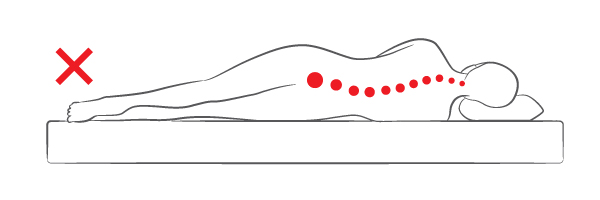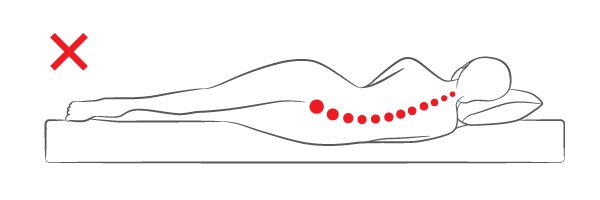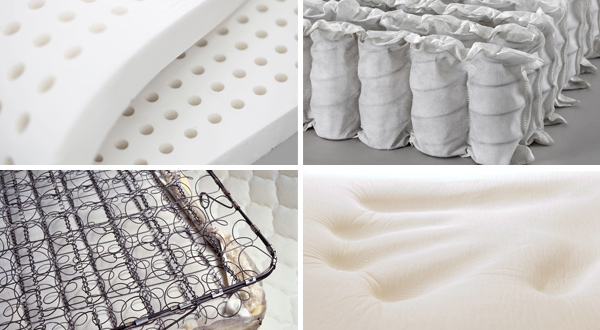Home » Mattress types » What Is An Orthopaedic Mattress?
Orthopaedic mattresses explained
Article navigation
- Tony Brown
When shopping for a new mattress, you may discover models labelled as ‘orthopaedic’. These mattresses are appealing to back sufferers because medical professionals seemingly endorse them. But are orthopaedic mattresses any good? Here’s what you need to know.
What is an orthopaedic mattress?
Orthopaedic mattresses can help support the spine and alleviate back pain. They were initially developed to address the inadequate support provided by softer mattresses, which can lead to an unnatural arch in the body and subsequent back pain. Orthopaedic mattresses provide a firmer, more supportive sleeping surface, addressing these issues and promoting better sleep.
Since there’s no industry standard for defining orthopaedic, many companies use the term for marketing purposes to give them an advantage over competitors. However, orthopaedic mattresses are not necessarily medically endorsed or proven to offer medical benefits.
Orthopaedic mattresses have evolved and improved because of technological advancements, materials, and a better understanding of sleep. While still popular, many sleepers prefer foam-based mattresses that contour to the body, providing gentle support and relief from pressure points during sleep.
Are orthopaedic mattresses good for back pain?
Orthopaedic mattresses are typically firmer than other mattresses, but this doesn’t necessarily mean they are good for a bad back. In the past, medical professionals often recommended firm mattresses for patients with bad backs. However, this advice has since changed. An overly firm mattress can contribute to back pain and painful pressure points.
Conversely, softer mattresses may also be problematic as sinking too much into them can put the spine in an awkward sleeping position. Heavier individuals may also find it difficult to change sleeping positions on softer mattresses.
Correct support depends on various factors, such as your body weight, build, height, and preferred sleeping position. In general, the heavier you are, the firmer the mattress you will need.
Heavier individuals often benefit from orthopaedic mattresses, as the firmer sleeping surface ensures the body is aligned and correctly supported. However, lighter individuals might experience discomfort, aches, pains, and painful pressure points from sleeping on an orthopaedic mattress.
Your preferred sleeping position can also influence whether to opt for an orthopaedic mattress. Side sleepers typically prefer a softer mattress that cushions the shoulders and hips. Orthopaedic mattresses provide a firmer feel and may not conform as well to body shape. In contrast, back and stomach sleepers usually require a firmer mattress that prevents the body from sinking too deep into the mattress. Orthopaedic mattresses can help prevent excessive sinking and maintain proper alignment.
If you’re experiencing back pain, consult your doctor or specialist before buying a new mattress.



What are the benefits of an orthopaedic mattress?
Orthopaedic mattresses benefit heavier individuals or those who prefer a firmer mattress. They can improve spinal alignment, alleviate back pain, reduce pressure points and improve sleep.
Even weight distribution
An orthopaedic mattress can help ensure the spine is aligned and correctly supported, evenly distributing your body weight across the sleeping surface.
Prevent partner disturbance
Orthopaedic mattresses absorb movement and help prevent or reduce partner disturbances during sleep.
Edge support
Orthopaedic mattresses typically provide good edge support. This ensures the mattress perimeter remains sturdy and supportive. Edge support prevents the sides of the mattress from collapsing or sagging. It extends the usable sleeping area, allowing you to sleep comfortably near the edge of the mattress without fear of falling out of bed.
Edge support provides more stability, making getting in and out of bed easier. This can be particularly beneficial for older adults or those with mobility issues.
Changing sleep positions
An overly soft mattress may lack support, causing the body to sink too deep into the mattress. Consequently, some sleepers may feel stuck and find it difficult to change sleeping positions. Orthopaedic mattresses address these sinking issues, making it easier for sleepers to move in bed.
What are the drawbacks of orthopaedic mattresses?
Some orthopaedic mattresses may lack sufficient cushioning for the body to sink comfortably into the mattress. This can often result in pressure points, numbness, poor circulation, aches, pains, and pins and needles.
How to determine if an orthopaedic mattress is too firm?
An orthopaedic mattress might feel too firm if you weigh less than 16 stone (102kg). It’s recommended that you try an orthopaedic mattress before buying to ensure it’s comfortable and supportive.
A simple check involves lying on the mattress on your back and sliding your hand underneath the lower part of your back. If you can easily slide your hand underneath, the mattress may be too firm. Alternatively, have someone check if your body is correctly aligned while lying on the mattress. You can also ask them to take a picture for you to assess.
How is an orthopaedic mattress different to a regular mattress?
The primary distinctions between orthopaedic mattresses and traditional mattresses lie in their firmness and support. Traditional mattresses provide a softer, more cushioned feel, allowing the shoulders and hips to sink into the bed. On the other hand, orthopaedic mattresses prevent excessive sinking, promoting better sleep posture. There’s no definitive answer as to which type of mattress is superior. Ultimately, the choice depends on personal preference and finding the most comfortable and supportive option for you.
Types of orthopaedic mattresses
There are different types of orthopaedic mattresses, each with its pros and cons.
Coil springs
Coil springs are commonly used in orthopaedic mattresses as they can be mass-produced inexpensively. An open coil unit is created from a single piece of wire, which is shaped to create a series of large interconnected springs.
While coil springs are usually more affordable, they may offer less support and have a bouncier feel than other orthopaedic mattresses. Movement is transferred across the entire sleeping surface, making it more likely for couples to feel each other’s movements.
Pocket springs
Pocket springs are smaller springs that work independently to conform and adjust to body shape. They are more supportive than coil springs, and as each spring works independently, there is less movement or ‘roll together’, meaning sleeping partners are less likely to disturb each other during the night.
Foam
Orthopaedic mattresses may contain memory foam or latex, which conform well to body shape and provide a more cushioned sleeping surface.
Memory foam is a temperature-sensitive material that can help relieve pressure points and alleviate aches and pains.
Latex is a resilient and durable material that quickly responds when pressure is removed. Like memory foam, it provides good support and pressure relief. Latex has a cooler sleeping surface but is typically more expensive.
How long do orthopaedic mattresses last?
The lifespan of an orthopaedic mattress can vary based on factors like construction, material quality, usage, and maintenance. With proper care, an orthopaedic mattress can last up to twelve years. Due to their firmer comfort layers, orthopaedic mattresses are typically durable and less prone to sagging than softer mattresses.
Final thoughts
Orthopaedic mattresses are a good option for those looking for a firmer and supportive sleeping surface. You don’t necessarily need a firmer mattress, but it should sufficiently support the body, allowing it to sink into it.
Share this article

About the author
Tony Brown is the founder and creator of The Bed Consultant. His career in the bed industry began in 2002. After graduating from university with a degree in Business Administration, Tony joined one of the largest independent furniture retailers in the UK as a bed consultant. Tony has helped thousands of customers find the perfect mattress.



